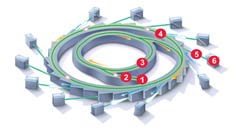
Handy Links
SLAC News Center
SLAC Today
- Subscribe
- Archives: Feb 2006-May 20, 2011
- Archives: May 23, 2011 and later
- Submit Feedback or Story Ideas
- About SLAC Today
SLAC News
Lab News
- Interactions
- Lightsources.org
- ILC NewsLine
- Int'l Science Grid This Week
- Fermilab Today
- Berkeley Lab News
- @brookhaven TODAY
- DOE Pulse
- CERN Courier
- DESY inForm
- US / LHC
SLAC Links
- Emergency
- Safety
- Policy Repository
- Site Entry Form

- Site Maps
- M & O Review
- Computing Status & Calendar
- SLAC Colloquium
- SLACspeak
- SLACspace
- SLAC Logo
- Café Menu
- Flea Market
- Web E-mail
- Marguerite Shuttle
- Discount Commuter Passes
-
Award Reporting Form
- SPIRES
- SciDoc
- Activity Groups
- Library
Stanford
Around the Bay
SLAC Light Sources, the Beautiful and the Bold
 SLAC is flush with light sources. SPEAR3 and SPPS are operating, and LCLS is under
construction. This acronym soup of machines has in common their end product: photons
of x-ray wavelength that can see into materials to make insightful images. They are
also dramatically different from each other.
SLAC is flush with light sources. SPEAR3 and SPPS are operating, and LCLS is under
construction. This acronym soup of machines has in common their end product: photons
of x-ray wavelength that can see into materials to make insightful images. They are
also dramatically different from each other.
Here's a brief primer:
SPEAR3 is a circular storage ring. Electrons radiate photons, from ultraviolet wavelengths
through hard x-rays, when magnets force them to make sharp changes of direction. The average wavelength
of the photons is one Angstrom, just the right distance to take snap shots of molecular complexes.
The machine was completely upgraded and reopened at the beginning of 2004 as a "third-generation" light source, capable of brighter x-ray beams and higher current. SPEAR3 will continue to be an invaluable research tool for years to come.
SPPS is the first femtosecond x-ray source using a linear accelerator (linac). By using a straight pipe for the electrons, researchers can make extremely short electron bunches, which in turn generate x-ray pulses 1,000 times shorter than those possible at SPEAR3. While SPPS studies the same size objects as SPEAR3, it can also capture ultrafast motions, which is like having a camera with the same size zoom lens, but a dramatically faster shutter speed.
SPPS began operating in May 2003 and will finish its last experiment March 20, 2006. Its successful operation provided an insight into the scientific opportunities that an x-ray free electron laser ( such as LCLS) can provide.
LCLS will also use the linac to make femtoseconds-long x-ray pulses. But LCLS will take it a step further, acting like a laser to amplify the number of x-rays and produce a coherent beam, where all x-rays are in phase with each other. The x-ray beam will be 10 billion times brighter than SPEAR3. The more powerful, coherent beam will allow researchers to make molecular movies of ultrafast dynamics and image single molecules one at a time.
LCLS is in the early stages of construction, and is expected to deliver "first light" to experimenters in 2009.
—Heather Rock WoodsSLAC Today March 17, 2006